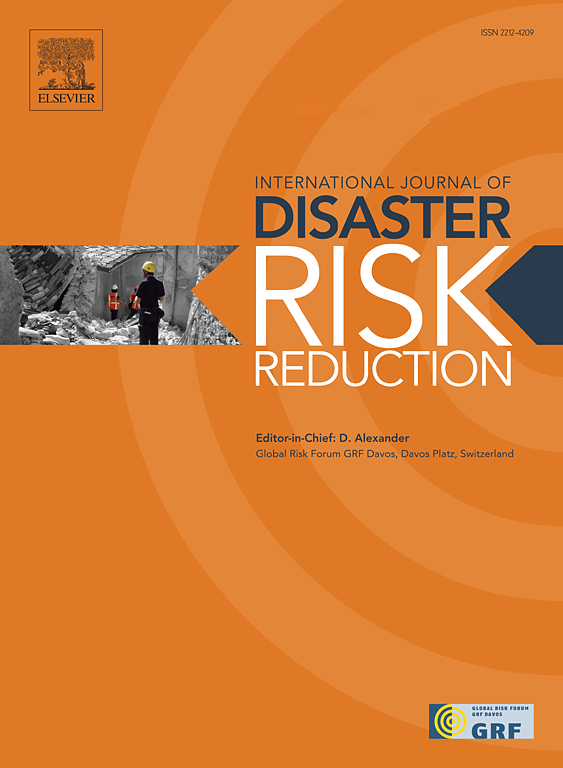表层之下:探讨韩国首尔住宅地下室洪水与收入差距之间的关系
IF 4.2
1区 地球科学
Q1 GEOSCIENCES, MULTIDISCIPLINARY
International journal of disaster risk reduction
Pub Date : 2025-04-17
DOI:10.1016/j.ijdrr.2025.105501
引用次数: 0
摘要
尽管近年来人们对洪水风险评估的兴趣日益浓厚,但洪水脆弱性与收入差距之间的关系仍未得到充分探讨,特别是在住宅地下室的维度上。为了解决这一研究差距,我们首先使用房屋销售价格和相关转换指数来估计建筑楼层的年收入。随后采用反向地理编码技术,将住宅地下室的收入数据分配到相关的建筑足迹中,以便进一步分析。该研究评估了2010年至2022年洪水事件对首尔不同收入群体地下室居民的影响。首尔是一个具有全球金融地位和高人口密度的城市,但也是一个易受洪水影响的城市。研究发现:(1)洪水事件对房屋销售价格较低地区的影响不成比例,这些地区也是低收入居民的主要居住地;(2) 85.3%的受影响地下室家庭属于中低收入群体,排名第10位及以下的低收入地区比例更高;(3)江西、九老区、松坡区、江南区等4个地区的高收入家庭总体上受洪水影响较小;(4)在部分街道中,中下收入地下室位于洪水风险高、社会经济脆弱性高的地区。研究结果提出了两个关键的政策启示,包括:(1)应优先考虑中下收入地下室居民,特别是高脆弱性街道的居民;(2)洪水风险信息应更有效地整合到住房市场中,以便更好地为潜在买家和政策制定者提供信息。本文章由计算机程序翻译,如有差异,请以英文原文为准。
Beneath the surface: Exploring relationship between pluvial floods and income disparities for residential basements in Seoul, South Korea
Despite the growing interest in flood risk assessment in recent years, the relationship between flood vulnerability and income disparity remains underexplored, especially in the dimension of residential basements. To address this research gap, we first estimated annual income at building floor level using housing sale prices and associated conversion indices. The reverse geocoding technique was subsequently adopted to assign income data of residential basements to associated building footprints for further analysis. This study assessed the impacts of flood events between 2010 and 2022 on different income groups of basement residents in Seoul, a city characterized by global financial standing and high population density, but also high vulnerability to floods. Our findings reveal that (1) flood events disproportionately impact areas with lower housing sale prices, which are also home to a large proportion of lower-income residents; (2) 85.3 % of affected basement households belong to the below-middle-income group, with even higher proportions observed in lower-income districts ranked 10th or below; (3) four districts Gangseo, Guro, Songpa, and Gangnam exhibit a pattern in which higher-income households are generally less affected by flooding; and (4) in some sub-districts, below-middle-income basements are located in areas characterized by both high flood exposure and socio-economic vulnerability. These results suggest two key policy implications, including (1) below-middle-income basement residents, particularly those in highly vulnerable sub-districts, should be prioritized in flood mitigation strategies; and (2) flood risk information should be more effectively integrated into the housing market to better inform both prospective buyers and policymakers.
求助全文
通过发布文献求助,成功后即可免费获取论文全文。
去求助
来源期刊

International journal of disaster risk reduction
GEOSCIENCES, MULTIDISCIPLINARYMETEOROLOGY-METEOROLOGY & ATMOSPHERIC SCIENCES
CiteScore
8.70
自引率
18.00%
发文量
688
审稿时长
79 days
期刊介绍:
The International Journal of Disaster Risk Reduction (IJDRR) is the journal for researchers, policymakers and practitioners across diverse disciplines: earth sciences and their implications; environmental sciences; engineering; urban studies; geography; and the social sciences. IJDRR publishes fundamental and applied research, critical reviews, policy papers and case studies with a particular focus on multi-disciplinary research that aims to reduce the impact of natural, technological, social and intentional disasters. IJDRR stimulates exchange of ideas and knowledge transfer on disaster research, mitigation, adaptation, prevention and risk reduction at all geographical scales: local, national and international.
Key topics:-
-multifaceted disaster and cascading disasters
-the development of disaster risk reduction strategies and techniques
-discussion and development of effective warning and educational systems for risk management at all levels
-disasters associated with climate change
-vulnerability analysis and vulnerability trends
-emerging risks
-resilience against disasters.
The journal particularly encourages papers that approach risk from a multi-disciplinary perspective.
 求助内容:
求助内容: 应助结果提醒方式:
应助结果提醒方式:


